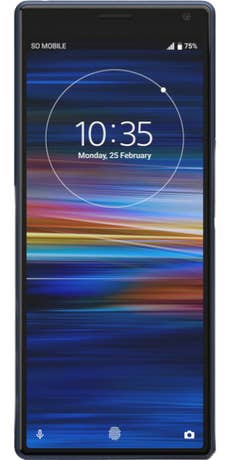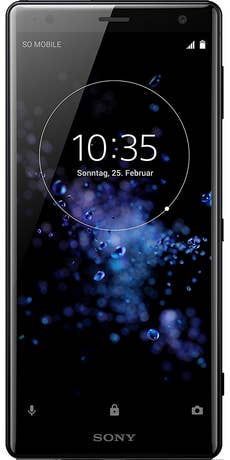Sony Xperia 10 vs Sony Xperia XZ2 Vergleich
- Daten
- Preise
Unterschiede hervorheben
Allgemein |
||
| Hersteller | Sony | Sony |
| Modell | Xperia 10 | Xperia XZ2 |
| alternative Modellbezeichnung | H8216 | |
| Verfügbar | ✓ | ✓ |
| Marktstart in Deutschland | Februar 2019 | 09.04.2018 |
| Einführungspreis | 349 € | 799 € |
| Aktueller UVP | 349 € | 799 € |
| Onlinepreis |
|
|
| Betriebssystem | ||
| Betriebssystem (OS) | Android Version: 9.0 Pie | Android Version: 8.0 Oreo |
Testergebnisse |
||
| Test auf inside digital | Testbericht | Testbericht |
| Gesamt | ||
| Design und Verarbeitung | ||
| Display | ||
| Ausstattung und Leistung | ||
| Kamera | ||
| Software und Multimedia | ||
| Akku | ||
| Akku | ||
| Wert nach 8 Stunden Nutzung | 68 % | 65 % |
| Wert nach 8 Stunden Nutzung plus 16 Stunden Standby | 55 % | 51 % |
| Verbrauch bei 8 Stunden Nutzung | 32 % | 35 % |
| Verbrauch bei 16 Stunden Standby | 13 % | 14 % |
| Antutu Benchmark | ||
| Version | 7.x | |
| Ergebnis Leistungstest | 88.011 | 258.397 |
Display |
||
| Display Größe | ||
| Pixeldichte | 457 ppi | 424 ppi |
| Auflösung B x H | 1.080 x 2.520 Pixel | 1.080 x 2.160 Pixel |
| Diagonale Zoll | 6 Zoll | 5,7 Zoll |
| Diagonale mm | 152,4 mm | 144,8 mm |
| Typ | LTPS | IPS |
| Material | Gorilla-Glas 5 | Gorilla-Glas 5 |
| Display-Format | 21:9 | 18:9 |
Gehäuse |
||
| Gehäusematerial | Aluminium, Glas | |
| Gehäuse-Format | ||
| Höhe x Breite x Tiefe | 156 x 68 x 8,4 mm | 153 x 72 x 11,1 mm |
| Schutzart | IP68 | |
| Schutz gegen | kein Schutz | Untertauchen |
| Gewicht | 162 g | 197 g |
| Farben | … | Schwarz, Silber, Grün, Pink |
Hardware |
||
| Prozessor | ||
| Prozessor / CPU | Qualcomm Snapdragon 630 | Qualcomm Snapdragon 845 |
| Arbeitsspeicher (RAM) | 3 GB | 4 GB |
| Akku | ||
| Akku Kapazität | 2.870 mAh | 3.180 mAh |
| Induktives Laden | ✗ | ✓ |
| Speicher | ||
| interner Speicher Größe | 64 GB | 64 GB |
| SD-Kartenslot | ✓ max. 512 GB | ✓ max. 400 GB |
| Arten | … | microSD, microSDXC, microSDHC |
| SIM-Kartenslot | Nano-SIM | Nano-SIM |
| Mehrfach SIM | ✓ Dual-SIM | ✓ Dual-SIM |
| Einschränkung: Hybrid-Fach | Ja | Ja |
| Sensoren | Beschleunigungssensor, Fingerabdrucksensor, Annäherungssensor, Helligkeitssensor | |
| Tasten | ||
| Hardware-Tastatur | ✗ | ✗ |
Konnektivität |
||
| LTE (4G) | ✓ | ✓ |
| 5G | … | … |
| WLAN | ✓ | ✓ |
| Standard | … |
IEEE 802.11a IEEE 802.11b IEEE 802.11g IEEE 802.11n IEEE 802.11ac |
| Band | 2.4 GHz, 5 GHz | |
Anschlüsse & Übertragung |
||
| USB | ||
| USB-Port | ✓ | ✓ |
| Typ | 3.1 Typ C | |
| Lightning-Connector | ✗ | ✗ |
| Bluetooth | 5.0 | 5.0 |
| Audio-/ Kopfhörerbuchse | 3.5 mm | ✗ |
| NFC | ✓ | ✓ |
| Radio | ✓ | ✗ |
Kamera |
||
| Kameraauflösung | 4160x3120 (13,0 Megapixel) | 5056x3792 (19,2 Megapixel) |
| Sensor | Sony Exmor RS | |
| Blende | f/2.0 | f/2.0 |
| Bildstabilisator | ✗ | ✓ Variante: elektronisch |
| Digitaler Zoom | ✓ | ✓ 8.0 - fach |
| Optischer Zoom | ✗ | ✗ |
| Videoauflösung | 3840x2160 (8,3 Megapixel) | 3840x2160 (8,3 Megapixel) |
| Aufnahmegeschwindigkeit | 30 fps | 30 fps |
| Blitz / Fotoleuchte | ✓ | ✓ |
| Testbilder |
   
|
Es sind leider keine Testbilder vorhanden.
|
Frontkamera |
||
| Frontkamera | ✓ | ✓ |
| Auflösung | 3264x2448 (8,0 Megapixel) | 2592x1944 (5,0 Megapixel) |
| Videoauflösung | 1920x1080 (2,1 Megapixel) | 1920x1080 (2,1 Megapixel) |
Sonstiges |
||
| Besonderheiten |
Dual-Kamera: 13 + 5 Megapixel Displayformat 21:9 Fotos und Videos im Format 21:9 |
Octacore: 4x2,6GHz/4x1,7GHz |
| Lieferumfang |
USB-Kabel Netzteil Bedienungsanleitung |
Netzteil Handbuch USB-C Adapter auf 3,5mm Klinke Headset |
Was unsere Symbole bedeuten …
- ✓ Ja/Vorhanden
- ✗ Nein/Nicht vorhanden
- … Bislang unbekannt/Wird ergänzt
Wir recherchieren gründlich, um dir die vollständigsten und genauesten technischen Daten zu liefern. Kontaktiere uns, wenn du etwas zu ergänzen hast.



